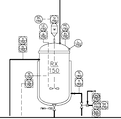
SERVICES
We are chemical engineers, and we work with companies developing or investing in new chemical, bioprocess, and energy technologies. Techno-economic modeling is our primary expertise and the foundation of our services.

Techno-economic modeling
We’ve developed models for over a hundred technologies, ranging from rare earth element recovery to plant-based proteins, carbon capture to coatings, and cement to water treatment. Each model is tailored to match the needs of the client and technology, but also leverages the templates, resources, and techniques that we have refined through years of deliberate practice and iteration.
We are comfortable working with technologies in all stages of development. Some clients hand us a basic engineering design for a demonstration system, some hand us a laboratory procedure, and others hand us an idea.
Broadly speaking, we build models from either the bottom up or from the top down. Bottom-up models we build from scratch – starting with a flow diagram and process model, and progressing through equipment sizing, equipment costing, and CapEx/OpEx estimation. Top-down models, on the other hand, are based on scaling from an engineering design study or published techno-economic analysis for a similar technology. Some models combine aspects of both.

Lifecycle / carbon intensity modeling
For a technology to be successful today, sustainability is often as important as economic viability. The term ‘lifecycle analysis’ can mean various things, but it is often used synonymously with carbon accounting. Carbon accounting quantifies the CO2 equivalence of process inputs and outputs and uses them to determine the CO2 intensity of the product.
This methodology fits seamlessly with techno-economic modeling. Both techno-economic modeling and carbon intensity modeling rely on material stream and utility rates as the basis for calculation. By building carbon intensity modeling into a TEM, we can leverage the same underlying process model and equipment sizing to dynamically estimate carbon intensity. We can then use sensitivity analyses to identify the parameters and process characteristics that have the highest impact.

Pilot plant design & cost estimation
Techno-economic modeling flows seamlessly into pilot plant design.
We regularly review and provide feedback on techno-economic models from clients. Sometimes, these models come from startups and apply to their own technologies. Other times, they come from investors and apply to technologies they are investing in.
We provide feedback on the model structure, assumptions, and references, as well as recommendations for improvements. Often, but not always, we end up rebuilding the model to improve usability and functionality and to incorporate our suite of sensitivity analysis modules.

Education & field development
Techno-economic modeling tends to raise as many questions as it answers, which is how it should be. After the initial model development, we can help clients identify, prioritize, and address key areas of uncertainty. Depending on the situation, this might include getting quotes on equipment or raw materials, speaking with vendors or industry experts, or developing conceptual engineering designs to move to the next step.

Other services
As a small company, we have the flexibility to occasionally take on other types of projects that fit our expertise and interests, such as:
-
Performing budgetary cost estimates on processes that we have modeled
-
Providing techno-economics education at startup incubators, fellowships, and universities
-
Writing white papers and technical reports
-
Helping clients launch internal techno-economics programs by offering mentorship to new hires and feedback on modeling efforts

Frequently asked questions
What is a techno-economic model?
A techno-economic modeling is a software model that examines how technical and financial parameters influence the economic value of a process or technology:
-
Technical parameters: R&D results and engineering assumptions
-
Financial parameters: Prices for raw materials, utilities, waste treatment, labor, etc. Factors for overhead, maintenance, etc.
-
Economic value: Levelized product cost, net present value, profit margin, payback, etc.
A good techno-economic model represents the best current understanding of a technology. It combines knowledge gained in the laboratory with engineering assumptions and costs to give a picture of a technology's economics at a commercial scale. Techno-economic models can be used to evaluate economic feasibility, guide R&D decisions, assess and mitigate risk, and manage development plans.
What software do you use?
We work primarily in Excel and VBA because it is accessible and adaptable. Excel is ubiquitous in science, engineering, and business communities. This makes it effectively free, which can be important for start-ups, but more importantly, it facilitates sharing, transparency, and communication across disciplines and organizations.
We use VBA to enable automated sensitivity analyses including tornado diagrams and Monte Carlo analysis, as well as to facilitate other aspects of our models.